<- Homepage: Kiwi: from lifted egg to free adult
Kiwi photo diary and reading diary
Day 1: locate, lift and transport a kiwi egg
The first day's mission was to head into Tongariro Forest, find a kiwi burrow and lift two North Island brown kiwi eggs from their nest for transportation to Rainbow Springs in Rotorua.
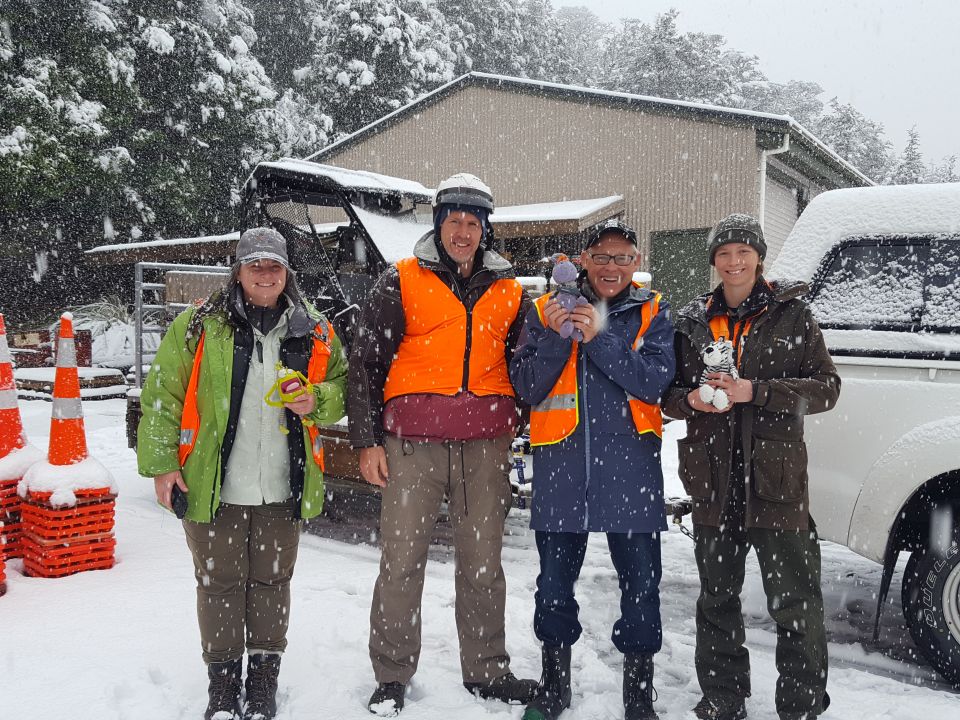
Outside the DOC office in Whakapapa Village after the web conference this morning - Marie, Andrew, Ruud, Jenny, and the ambassadors.

Andrew, Ruud and the team are all set to go in the LUV. Should have cleared the snow from the roof before driving off!
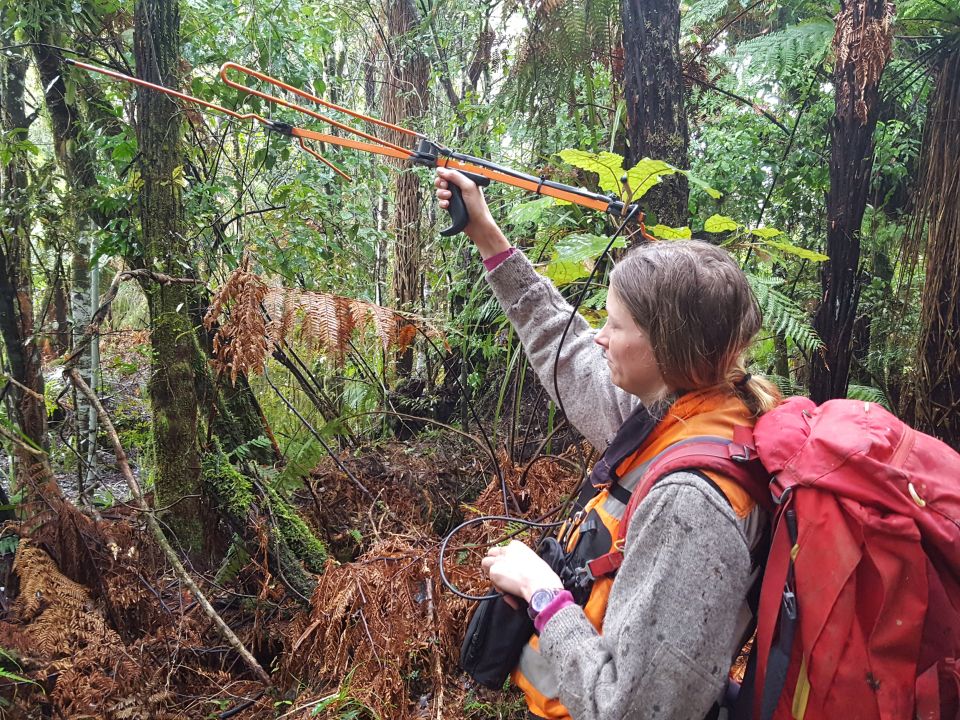
Jenny receives a signal through the aerial which tells her that the kiwi's burrow is not too far away. What is sending the signal?
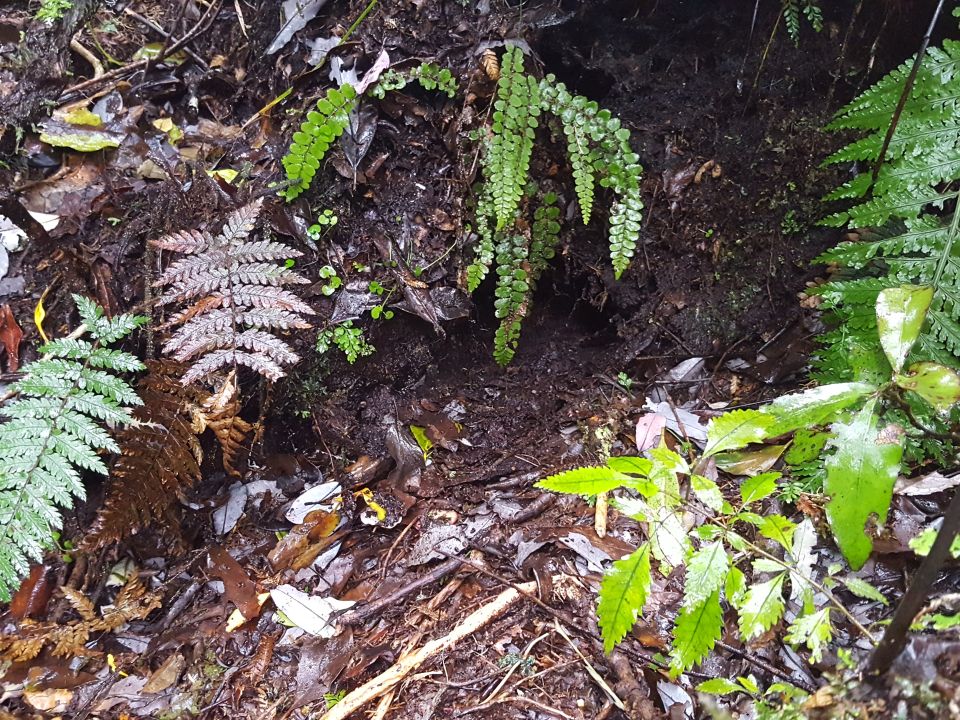
The entrance to the kiwi burrow. Do you think you could find this without the telemetry gear?

Jenny reaches into the burrow to carefully remove one of the eggs.
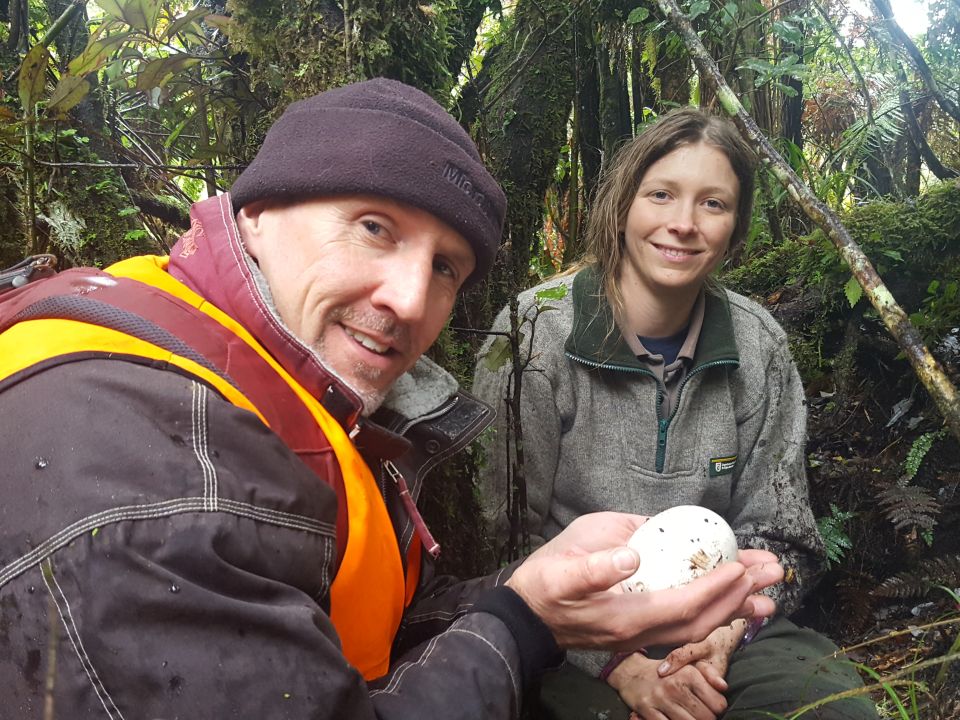
The smile says it all as Andrew carefully holds one of the kiwi eggs.
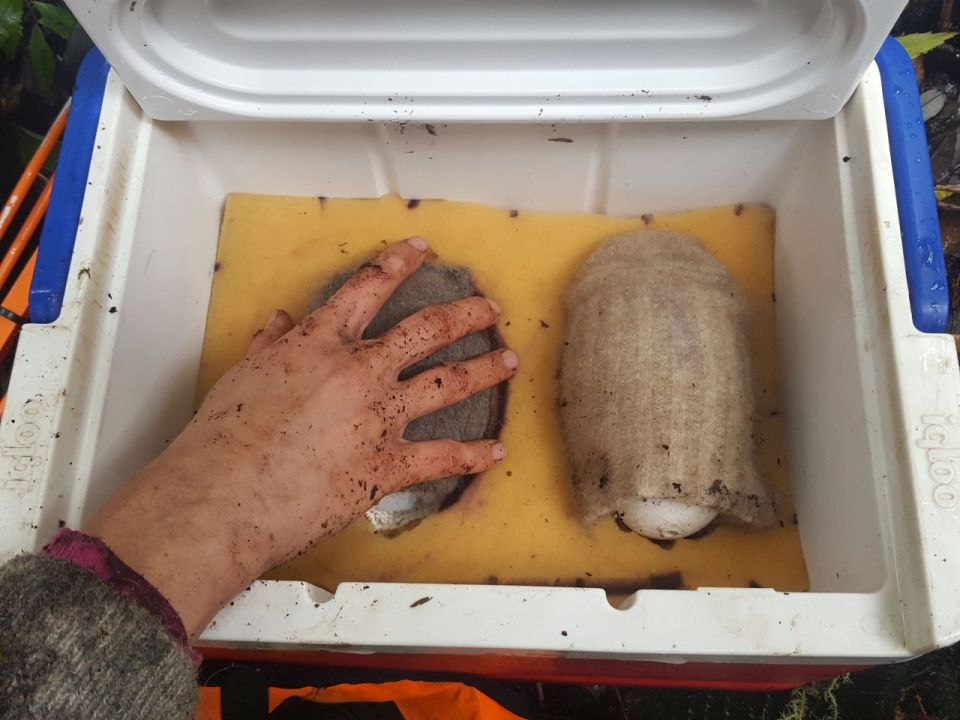
The kiwi eggs are delicately packed into the chilly bin. What helps to keep them safe and warm?
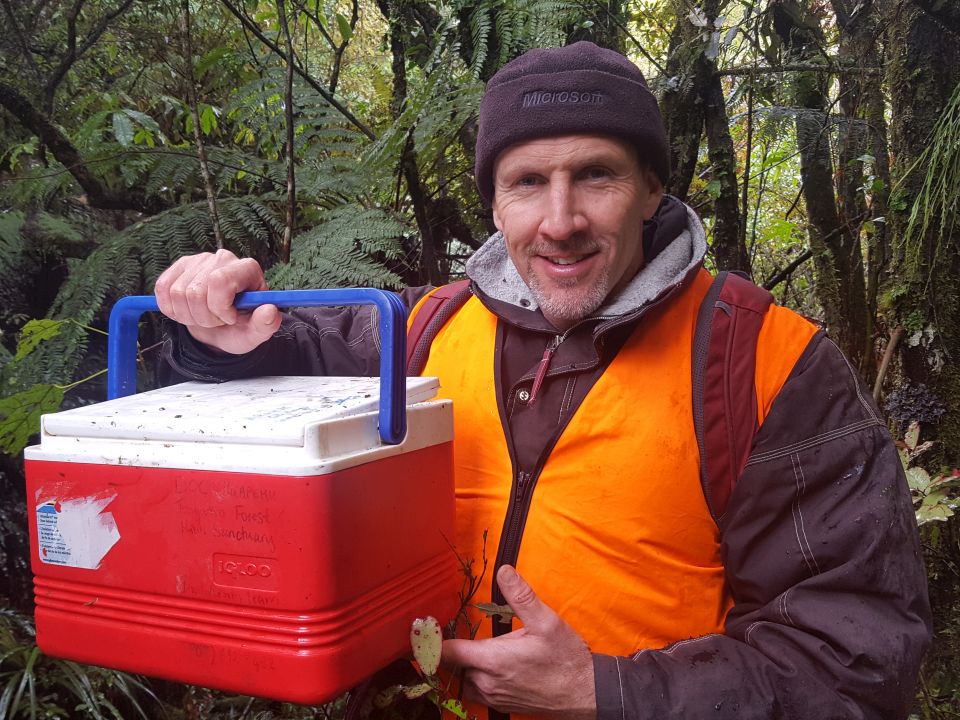
With the egg safely packed in the chilly bin it is time to head to Rainbow Springs Kiwi Encounter.

A photo showing the candling process. You can see the air cell and some veins from the embryo.
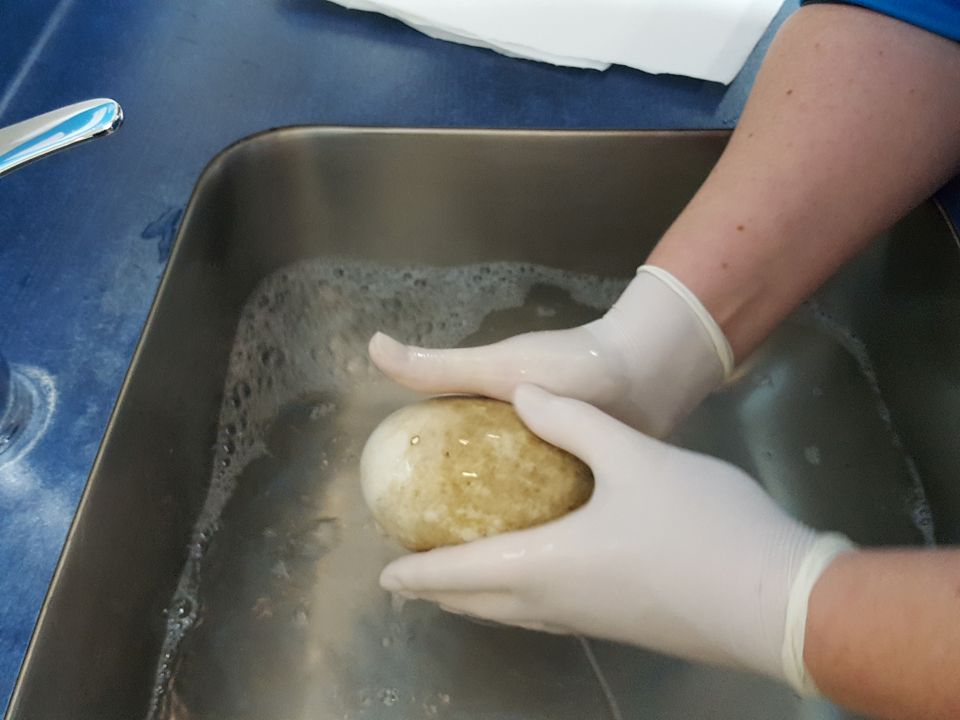
Washing the egg is an important step when eggs arrive at Rainbow Springs, especially when they are this dirty! Apart from getting them a bit cleaner, what else would washing them do?
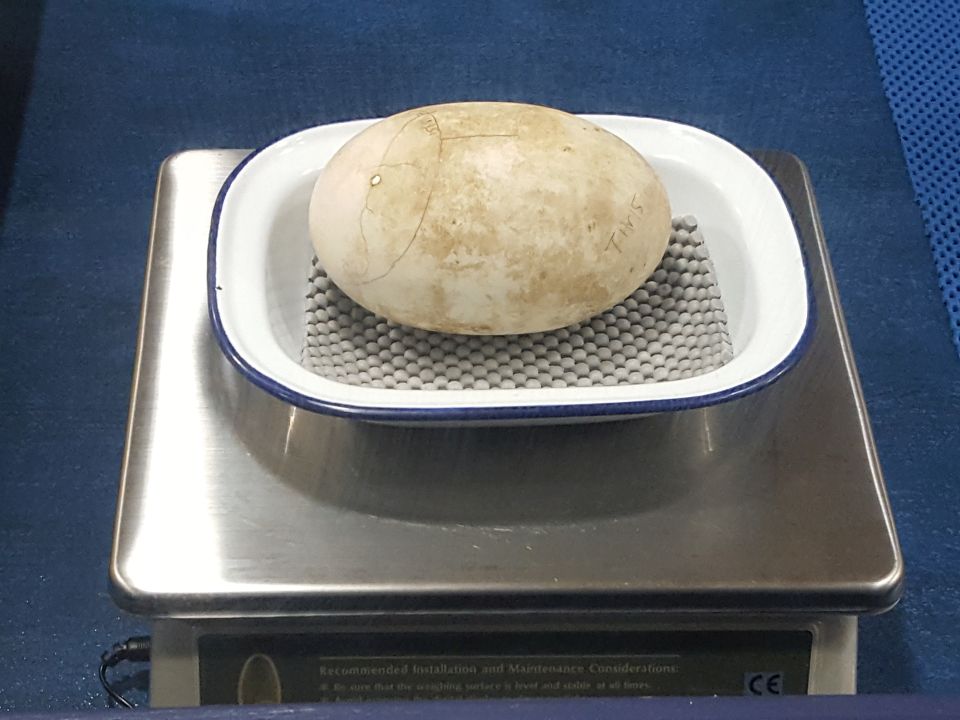
Weighing each egg is another part of the process. Can you see the pencil lines? What do you think they show?
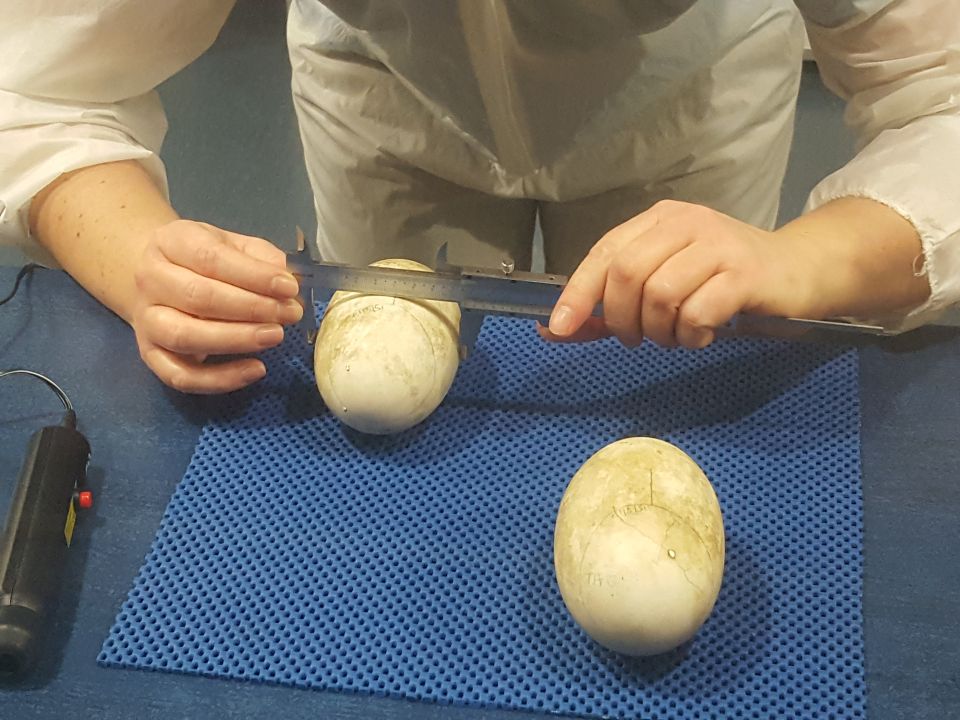
Emma even measures the width and the length of each egg.
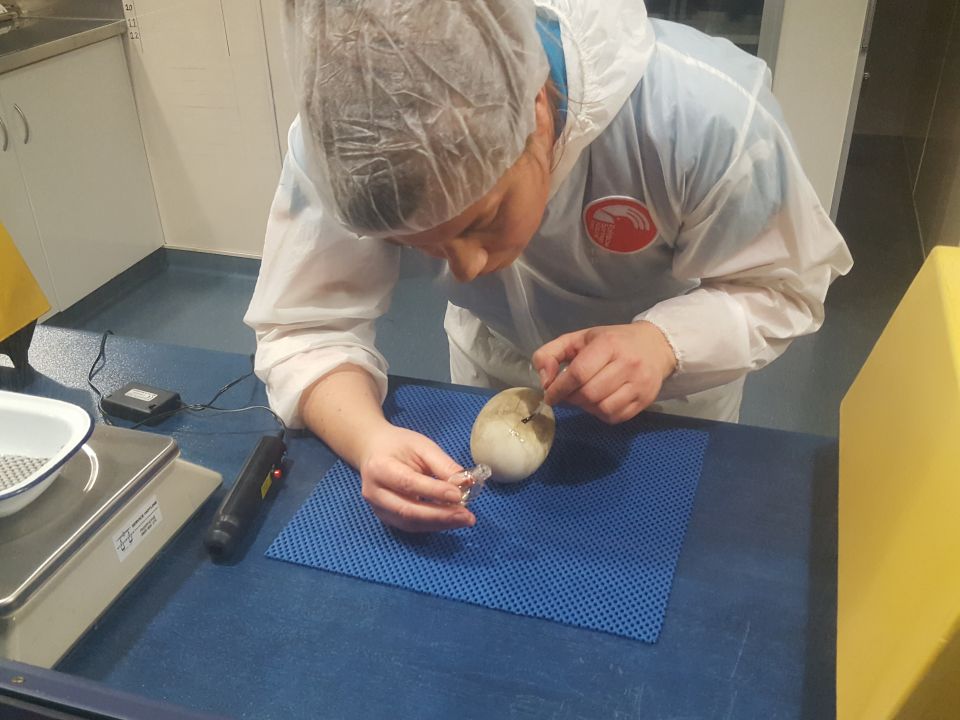
Emma gives the small crack in this egg shell a quick patch-up.
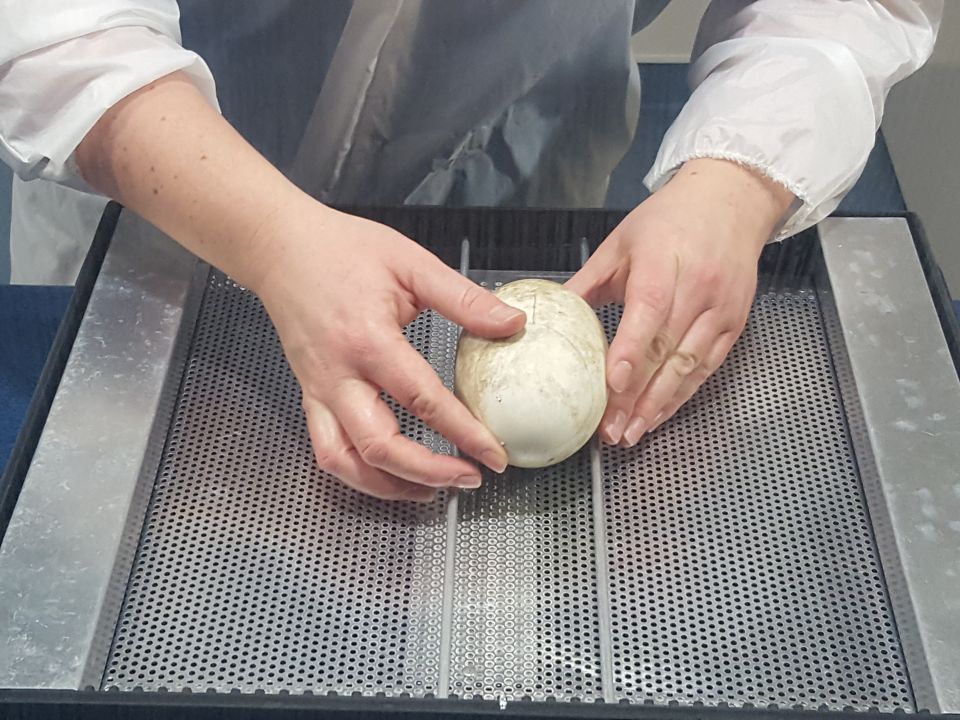
The egg is now ready to be placed inside the incubator, with the lid still to come!
Day 1 reading diary
Kia ora tātou, Andrew here,
What a day - it’s been all go, I tell you! From finding and lifting kiwi eggs in Tongariro Forest, to delivering them to Kiwi Encounter at Rainbow Springs in Rotorua. The action has been non-stop all day.
A white web conference
We had the first of our web conferences this morning at the DOC office in Whakapapa Village. And it was snowing! Dyers Street School was the speaking school and Ruud Kleinpaste, Jenny Hayward, and Marie McDonald were our experts. A recording of this session can be found on the web conferences page.
Into Tongariro Forest
After the web conference it was time to head to Tongariro Forest. It wasn’t snowing outside of Whakapapa but it was drizzling and still quite cold. We drove for a while then turned off the main road. Down a bumpy, pothole riddled track we went, arriving at a point where we couldn’t go any further - at least not in the Hilux.
To go further into the forest the we had to change vehicles. Now we would be riding in an LUV - light utility vehicle. These great little machines can travel across rough, steep, mud-soaked terrain. And that is exactly where we went!
With seat-belts and helmets on, the ambassadors and I held on tight in the open back part of the LUV. Jenny drove and Ruud rode shotgun. But as we took off a large lump of snow slid off the roof and landed all over me! It was quite funny but soon forgotten, as we bounced and rattled our way along. It was quite exhilarating! We would have to drive back with more care when we had the kiwi eggs on board!
Tracking kiwi eggs
We finally arrived at the point where we could continue on foot into the forest itself. Jenny got the aerial and radio receiver working, and we trudged through thick, damp native forest. It certainly felt like good kiwi habitat, and Ruud Kleinpaste agreed. Watch the video where Ruud explains why kiwi thrive in these sorts of locations.
The radio receiver was soon giving off loud beeps which meant the transmitter (attached to the leg of the kiwi incubating the egg) was not far away. Jenny soon spotted the kiwi’s burrow. She pointed out a worn path leading to what was quite an obvious entrance. We were all very excited. The burrow seemed to be under an old fallen log with all sorts of things growing on and around it. Jenny had a bit of a look in and around the burrow entrance with a torch. Once she was happy with what she saw she reached in and gently pulled out one of the kiwi eggs, followed by the second one. It is common for North Island brown kiwi to lay two eggs at a time.
Both eggs were then wrapped in a possum wool sleeve and placed between moulded foam slabs, all inside a chilly bin to keep them safe and at the right temperature. Success! But the job was only half done. We now had to get the egg safely to Kiwi Encounter at Rainbow Springs in Rotorua for processing.
Operation Nest Egg continues
We trudged back through the forest to the LUVs and made our way back to the Hilux. I was feeling elated and as we drove along, I cradled the chilly bin with the eggs inside. This was Operation Nest Egg in action, and we were a part of it!
Once back at the other vehicle we transferred the precious cargo, said goodbye to Jenny, and began the journey to Rotorua. After a two and a half hour drive, we reached our destination, Rainbow Springs, where we were able to safely deliver the eggs to Emma Bean for processing. Phew!
Working with the egss
Inside Rainbow Springs Kiwi Encounter, Emma quickly got to work. There were several tasks to do, such as cleaning, candling, weighing, measuring, drawing on, and even fixing the eggs. Make sure you watch the video where Emma explains the parts of this process in more detail.
After all of these tasks were completed, the eggs were finally placed inside an incubator. You’ll find out more about that tomorrow. For now, we’ve all earned a jolly good rest - it’s been quite a day!
Catch you again tomorrow,
Andrew
Day 2: incubate and hatch a kiwi egg
On the second day watch the people looking after the eggs and newly hatched chicks in the kiwi captive rearing facility and go to the sanctuary to find out what kiwi like to eat.
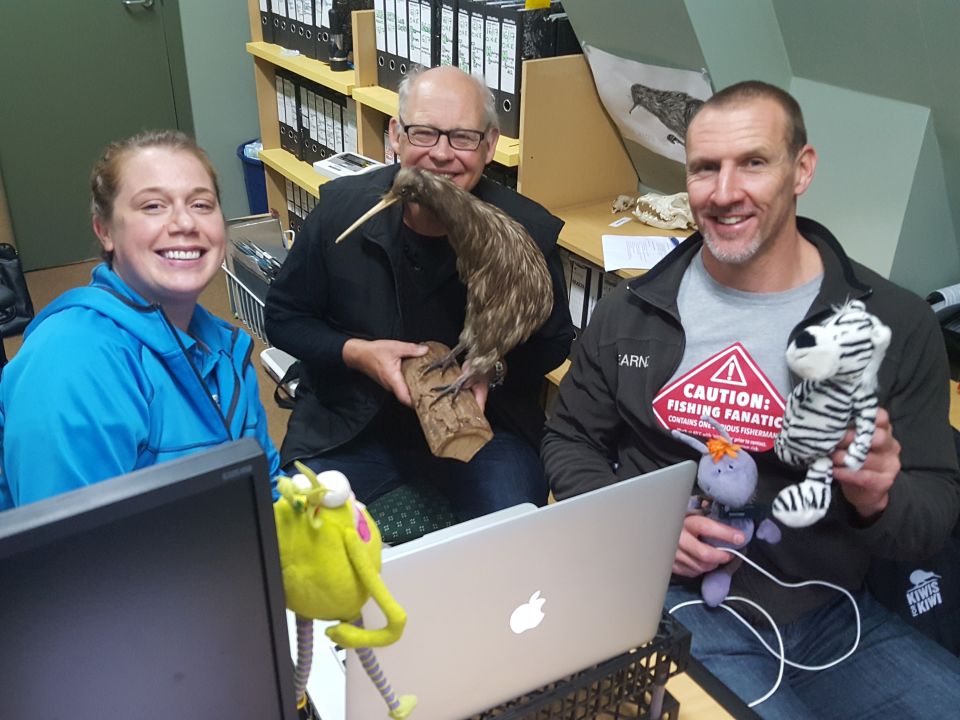
Emma Bean, Ruud Kleinpaste, Andrew and the ambassadors on this morning's web conference.
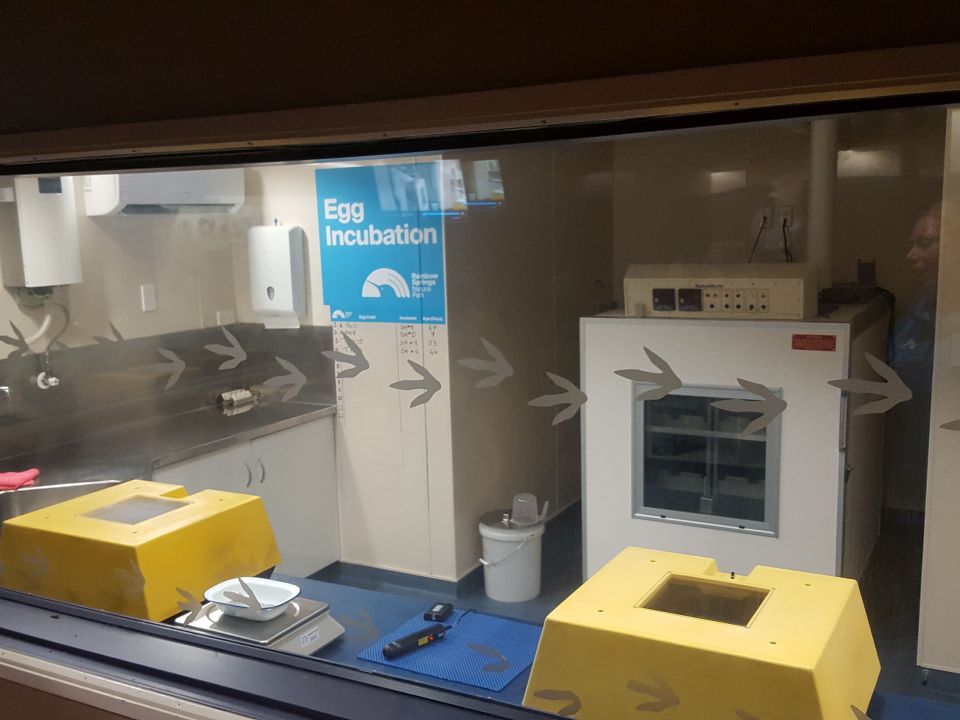
The egg incubation room at Rainbow Springs Kiwi Encounter.
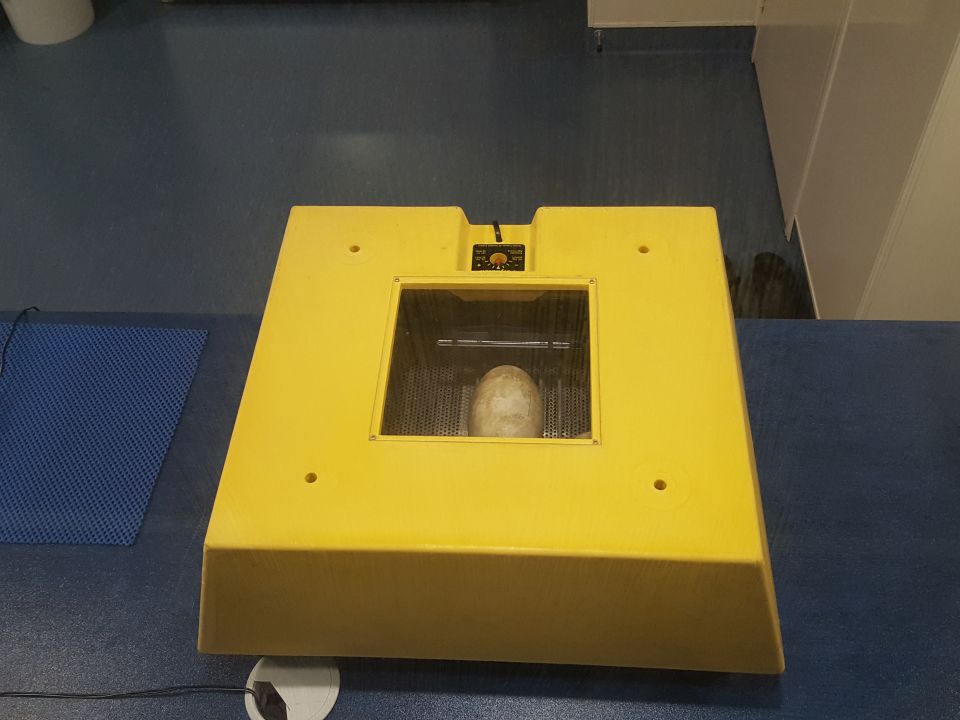
A closer look at an incubator with one of the Tongariro Forest kiwi eggs inside. What temperature are the eggs incubated at?
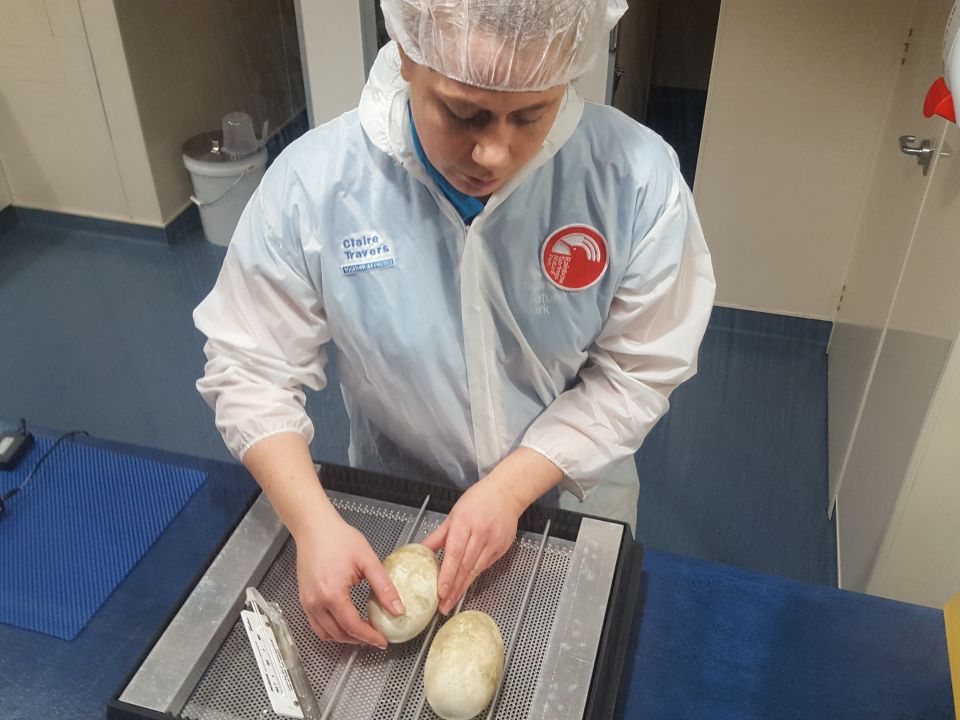
Emma turns the eggs. Why is this such an important task? Image: LEARNZ.
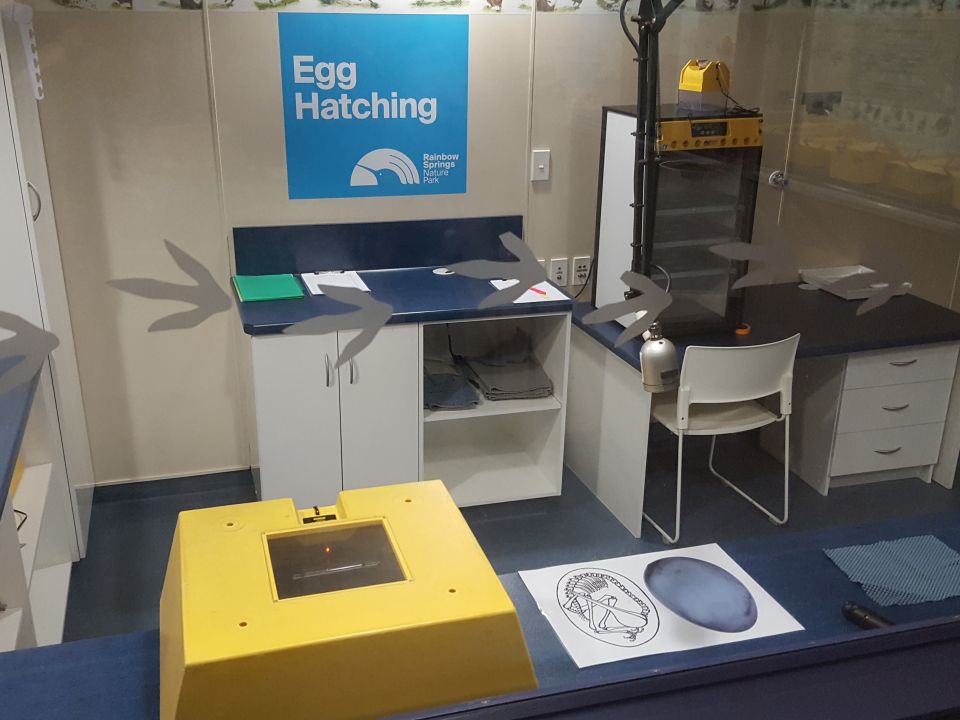
This is where egg hatching happens at Rainbow Springs Kiwi Encounter. Go to the videos to see a kiwi chick hatching. Image: LEARNZ.
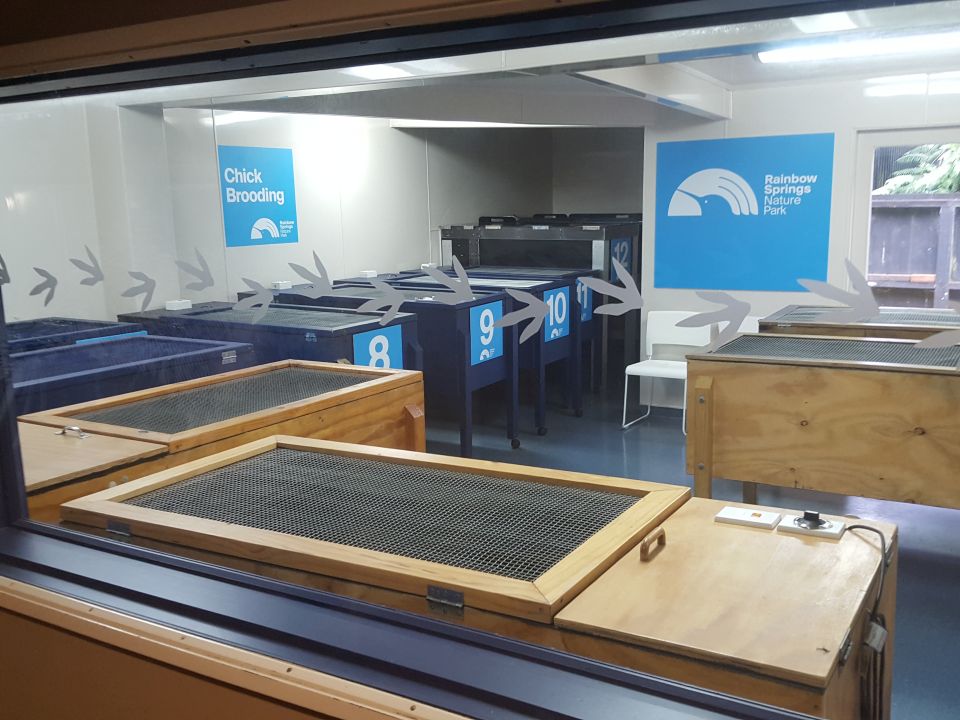
Here is the brooder room, with some of the brooder boxes. Can you imagine what it must be like when all these boxes are filled with kiwi chicks?
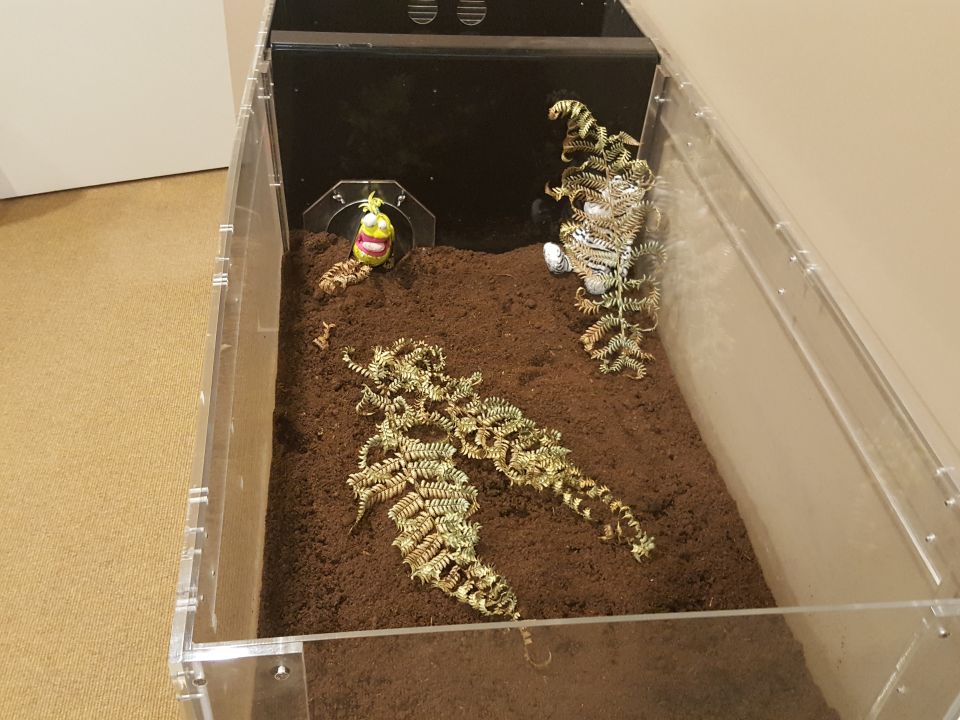
This is a display brooder box set up to show you what it is like inside for the newly hatched kiwi chicks. The ambassadors seem to be enjoying themselves in it!
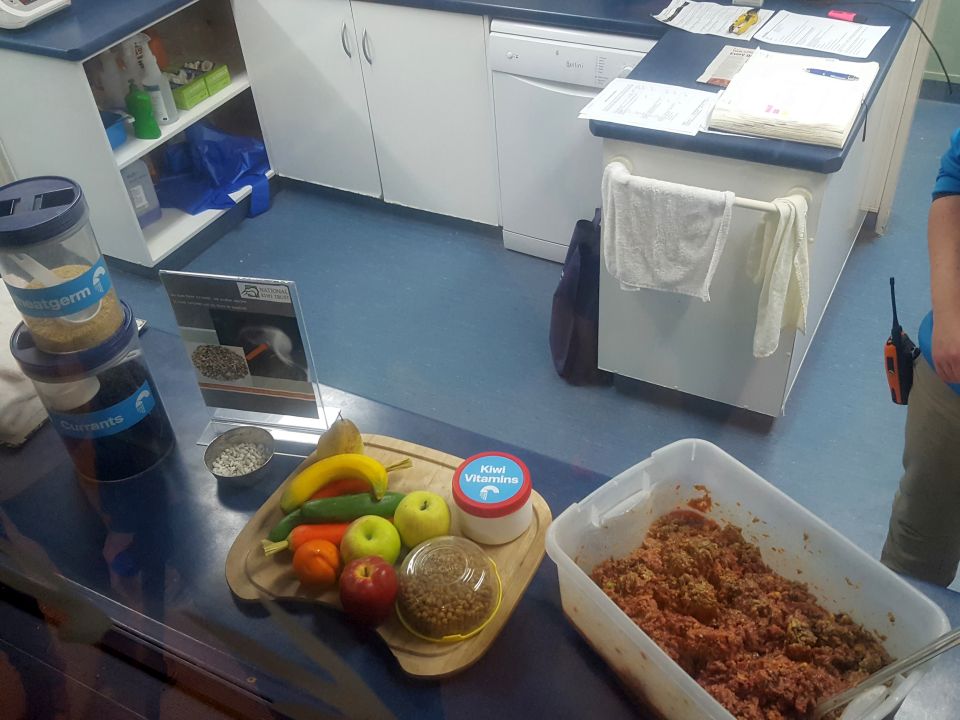
Here you can see the food that is fed to the kiwi chicks. It is a specially formulated diet to maximise growth and health. I wonder how people came up with this diet.
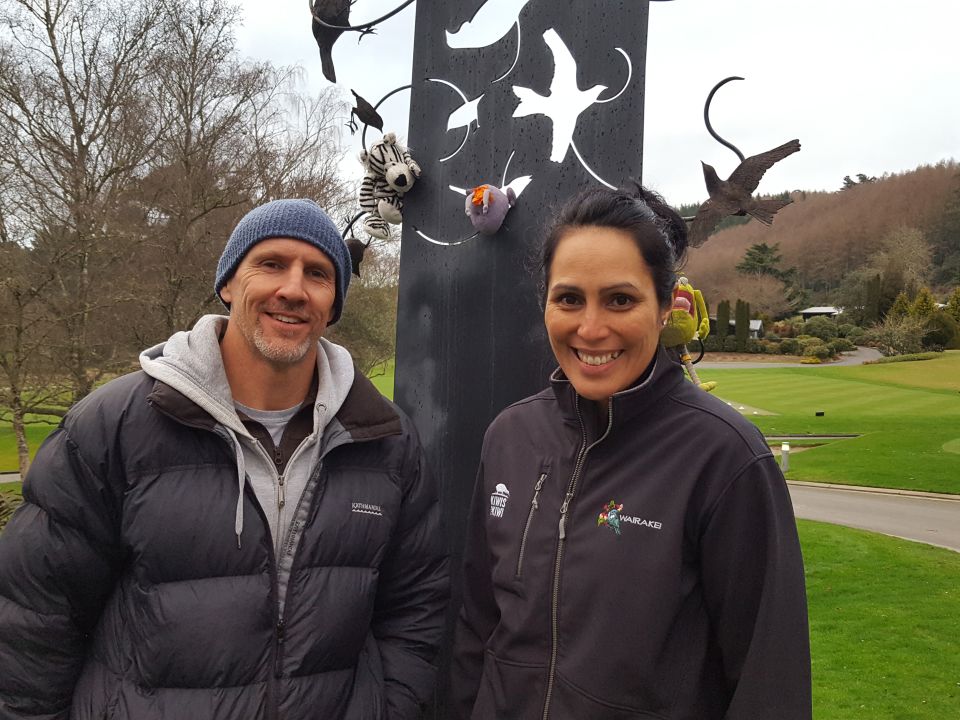
Andrew with Renee at Wairakei Golf Sanctuary.
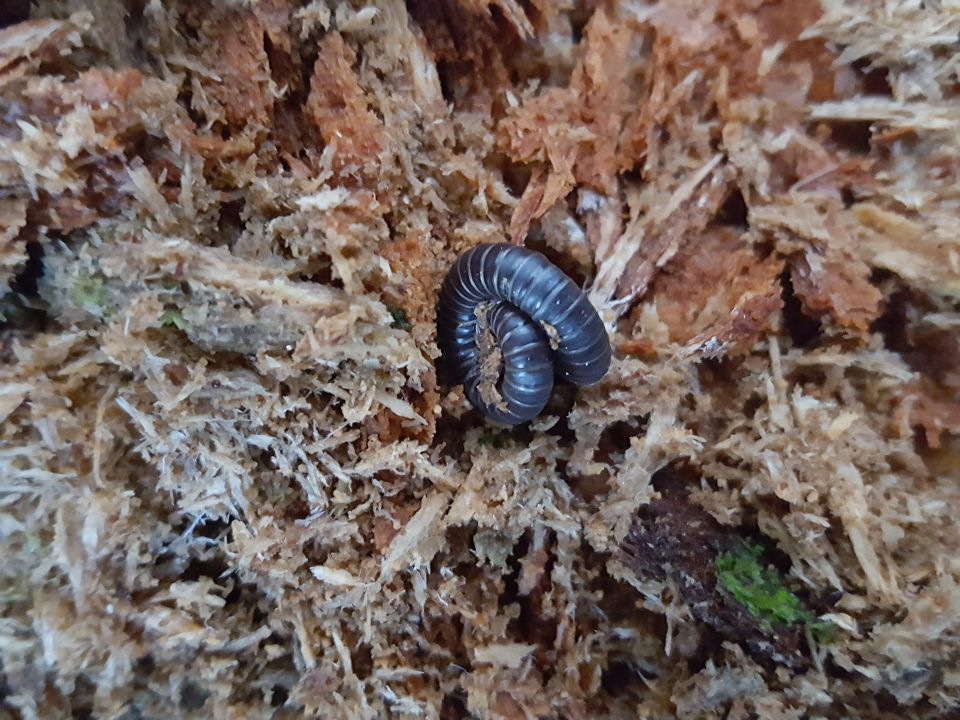
One of the invertebrates Ruud Kleinpaste found in a rotting log. Do you know what this invertebrate is called? I wonder why it is all twisted like that.
Day 2 reading diary
The second day saw the team incubating and hatching an egg at Rainbow Springs as well as finding the sort of food that a growing kiwi needs.
Kia Ora everyone, Andrew here,
This morning the ambassadors and I went back to Rainbow Springs in Rotorua, and afterwards we drove to Wairakei Golf Sanctuary in Taupō - but not to play golf!
Web conference
Once again, we started our day with the web conference. Our speaking schools this morning were Lepperton School & Hornby High School, with Ruud Kleinpaste and Emma Bean answering the questions. It was quite a long web conference but also lots of fun! If you can make the time, I recommend listening to the recording that you can access on the web conferences page.
Incubation and hatching
Yesterday you saw what happens to the kiwi eggs on arrival from Tongariro Forest. The next step for the team at Rainbow Springs Kiwi Encounter is to put each egg into an incubator. The incubators keep the eggs at the right temperature - 35.5 degrees Celsius. This, of course, is the temperature the eggs would be in a nest in the wild when the male sits on them to keep warm.
The eggs also need to be turned, as they would be in the nest by the male parent. It always needs to end back up the right way but turning it makes sure that the heat is evenly spread throughout the egg, as well as mixing all the nutrients around the egg to keep the embryo growing well. You can watch the video with Emma Bean for a more thorough explanation of this stage of Operation Nest Egg.
The brooder room
The next important part of the rearing unit is the brooder room. A brooder is a bit like a nursery and is where the newly hatched chicks are placed. They spend their time here in a brooder box, putting on weight and getting stronger before being taken to a predator free crèche - more about that soon! They are fed a special diet to help maximise this weight gain and to ensure the best health possible.
The chicks are monitored closely but are only handled if necessary. This is because they will soon be released into the wild and it is important they do not get too used to human contact.
The ups and downs of putting on weight
It was interesting to learn from Emma how much the weight of both an egg and a chick changes. But the weight doesn’t necessarily go up all the time, it also goes down. An egg, for instance, loses water and carbon dioxide and gains oxygen. So even though the embryo is growing, it is normal for the egg to get lighter.
It is also normal for a new-born chick to lose weight before putting it back on again. Within the first week, the chick uses up the rest of the egg yolk it absorbed into its stomach before hatching. As it feeds on this yolk its weight drops. Once it starts eating food each day it begins to gain weight again.
Crèche time
When the kiwi chicks are about two weeks old, they are moved from the brooder pens to a crèche. At the crèche, their job is to learn how to be a kiwi in the wild, as well as to reach a weight at which they can better defend themselves against predators. Captive reared chicks that have come from Tongariro Forest are taken to Wairakei Golf Sanctuary in Taupō, and it was here that we met Renee Potae and finished off our day.
Renee explained how the sanctuary has a dedicated five-kilometre fence around the entire course perimeter. The fence stands more than 2 metres tall and has been specially designed to keep out predators like rats, mice, stoats, weasels, hedgehogs, feral cats and possums. This predator free environment also has excellent habitat for kiwi to live in around the golf course, making it an ideal safe place for kiwi to ‘find their feet’ and grow.
The Bugman strikes again
At first, I was a bit unsure how a golf course would be a suitable habitat for kiwi. But wandering off the fairway with Ruud Kleinpaste into the bush, you could see that it is in fact a great place for kiwi to ‘grow up’. Ruud was able to show many examples of invertebrates that kiwi would happily eat - invertebrates that live in the litter layer, further down in the soil, and in places such as rotting logs. When you watch the video, you will see that kiwi living here would never go hungry!
It has been another fascinating day seeing how the parts of Operation Nest Egg fit together. Tomorrow you will get to see the final part of the process.
Catch you again tomorrow morning,
Andrew
Day 3: find a captive reared kiwi and return it to the forest
On the third and final day it was time to complete the circle of Operation Nest Egg by finding a young, captive reared kiwi and returning it to Tongariro Forest.

The team head off in golf carts in search of a kiwi.
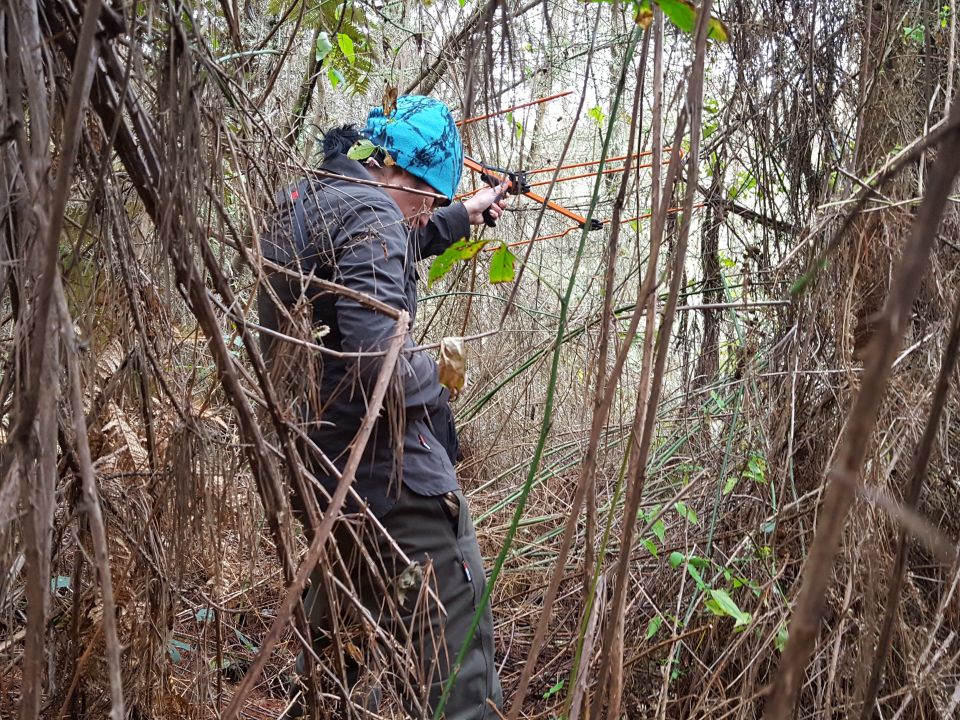
Renee is hot on the trail of the young kiwi. You can see how difficult it might be to find a kiwi in this undergrowth.

It's hard not to smile when you're holding one of these special birds. Image: LEARNZ.

Measuring a kiwi's beak is part of the health check and can indicate whether the bird is male or female. Image: LEARNZ.
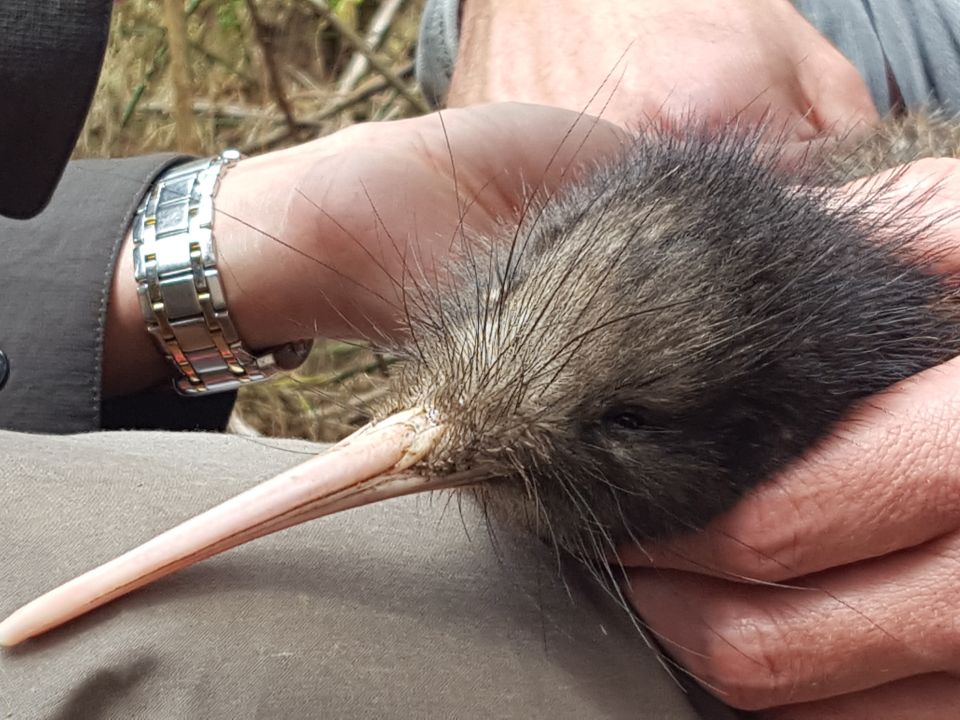
A close look at kiwi whiskers. How do they help it?
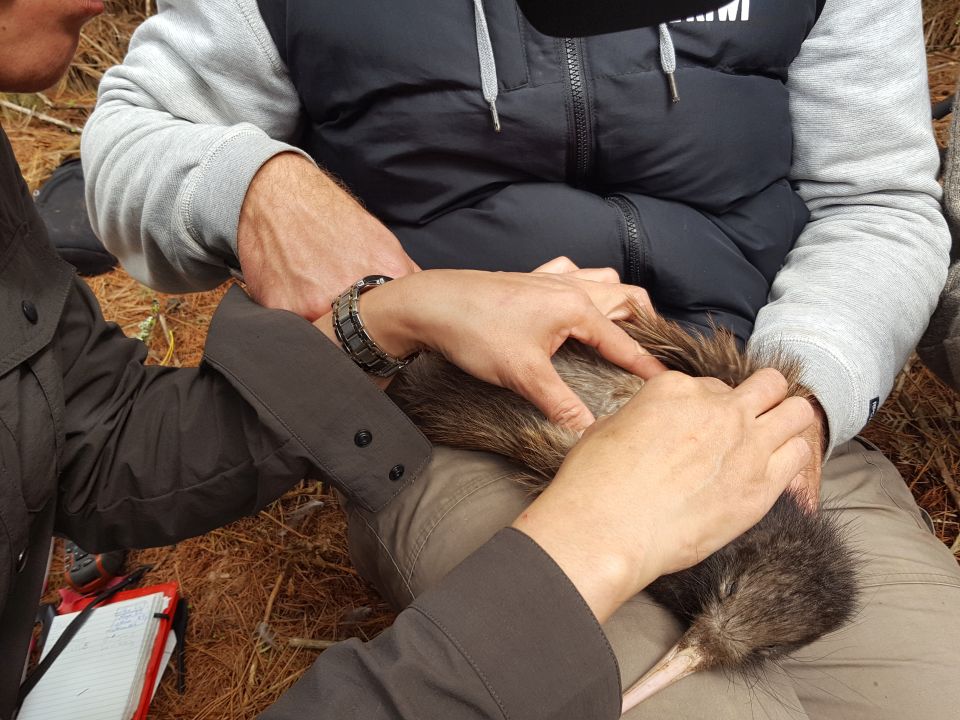
Checking under their little wings is a good place to look for fleas, ticks or mites on a kiwi.
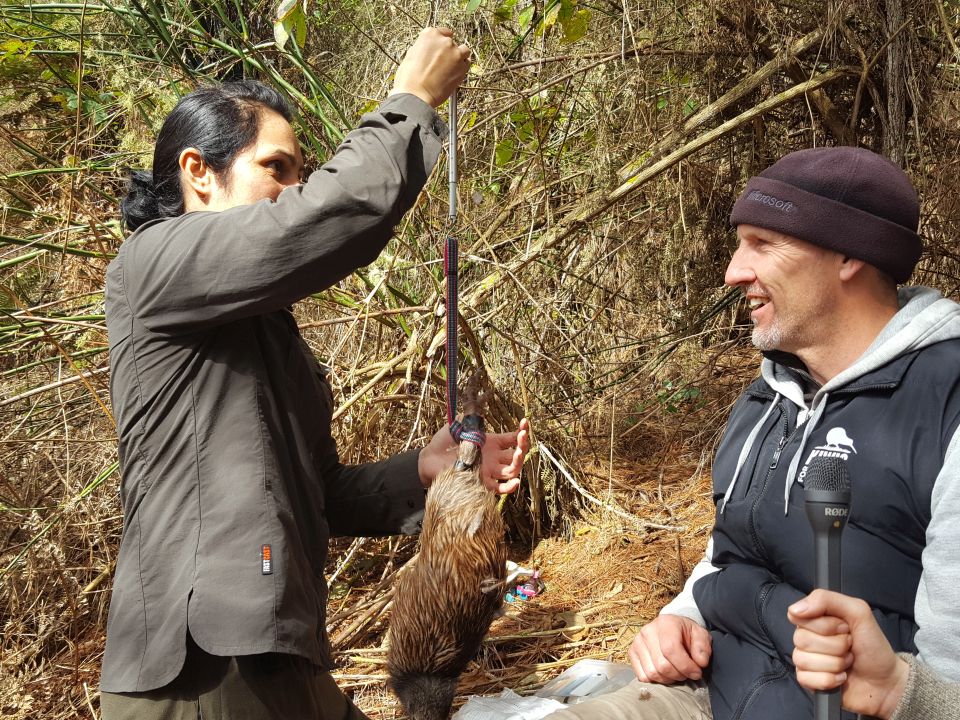
Weighing the kiwi will determine whether it can be returned to Tongariro Forest. What weight does the kiwi need to be before it can go back into the wild?
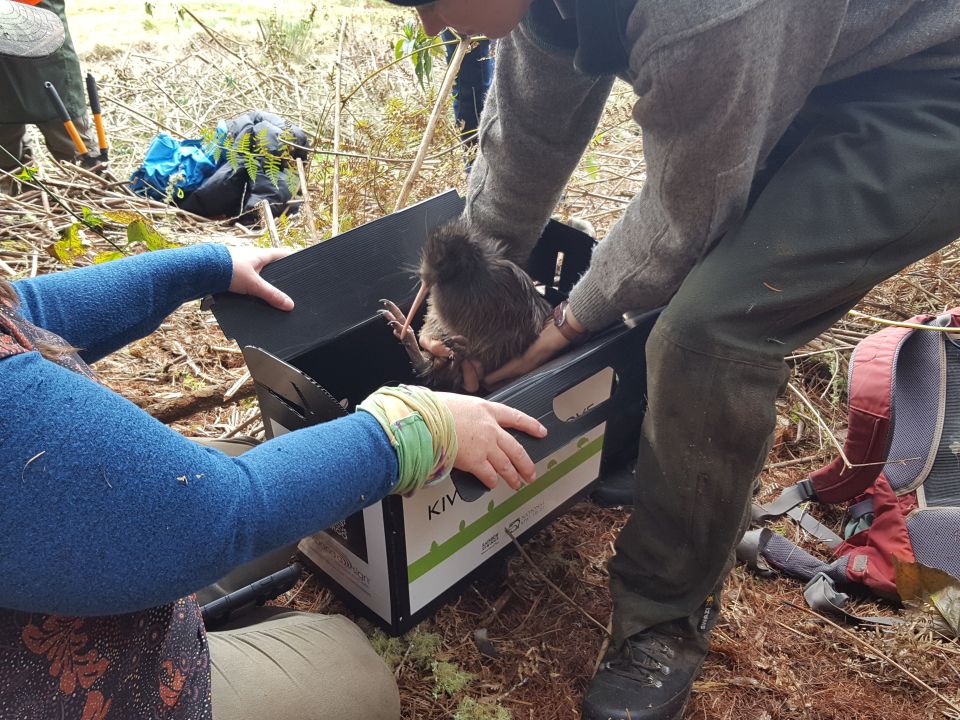
The young kiwi is placed into a secure box ready for transportation back to Tongariro Forest.
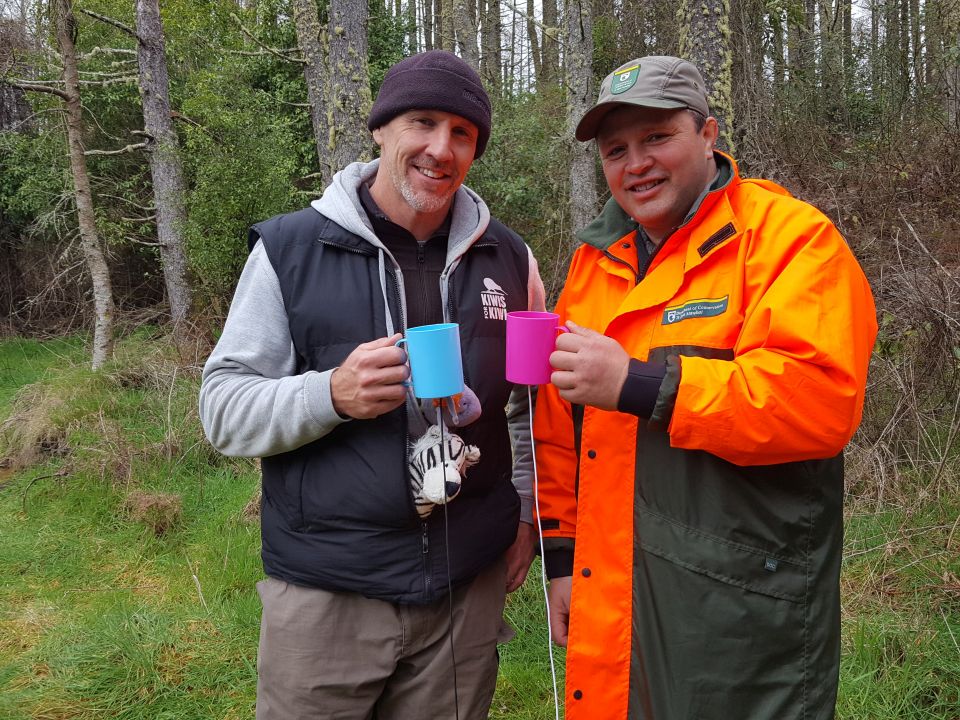
Andrew with Matt. You will have to watch the video to find out why they are holding these cups.
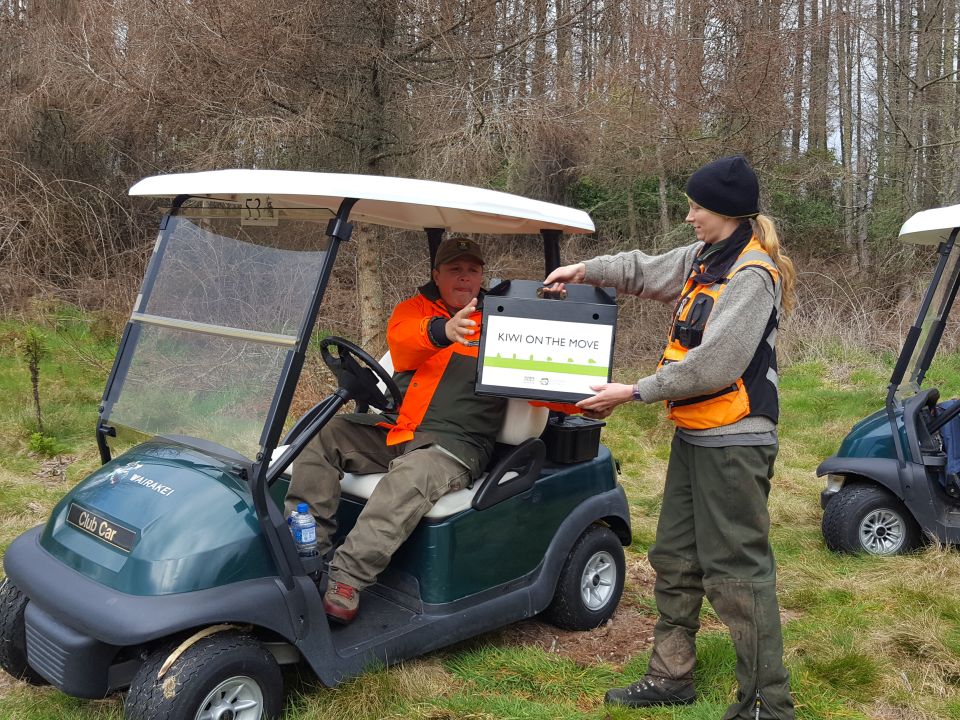
Jenny passes the young kiwi over to Matt. Its journey back home has begun.
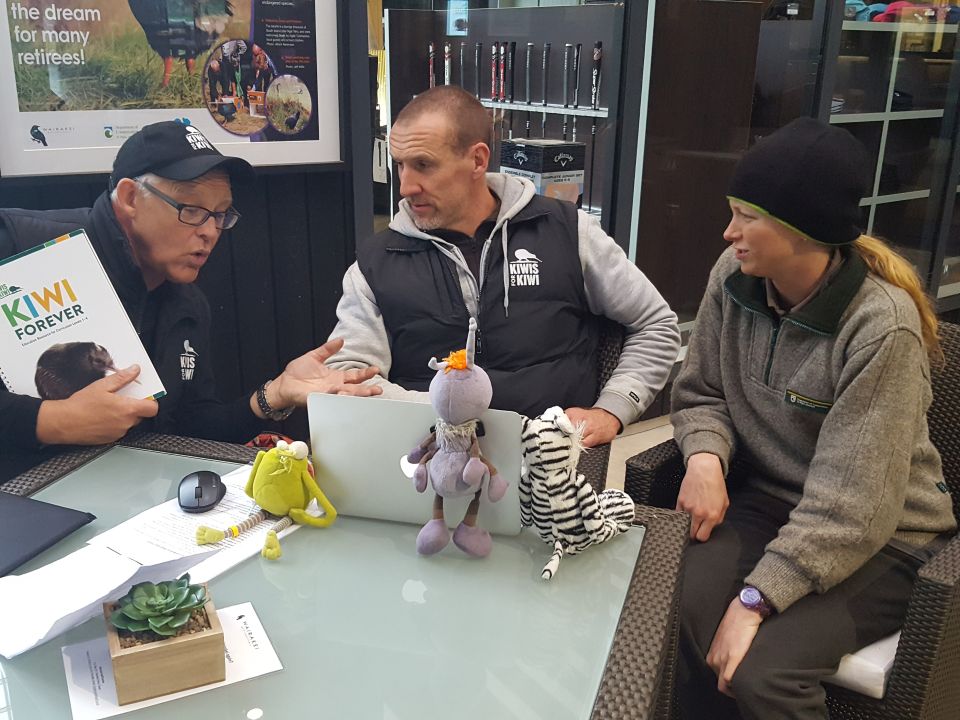
Ruud, Andrew, and Jenny on this afternoon's web conference.
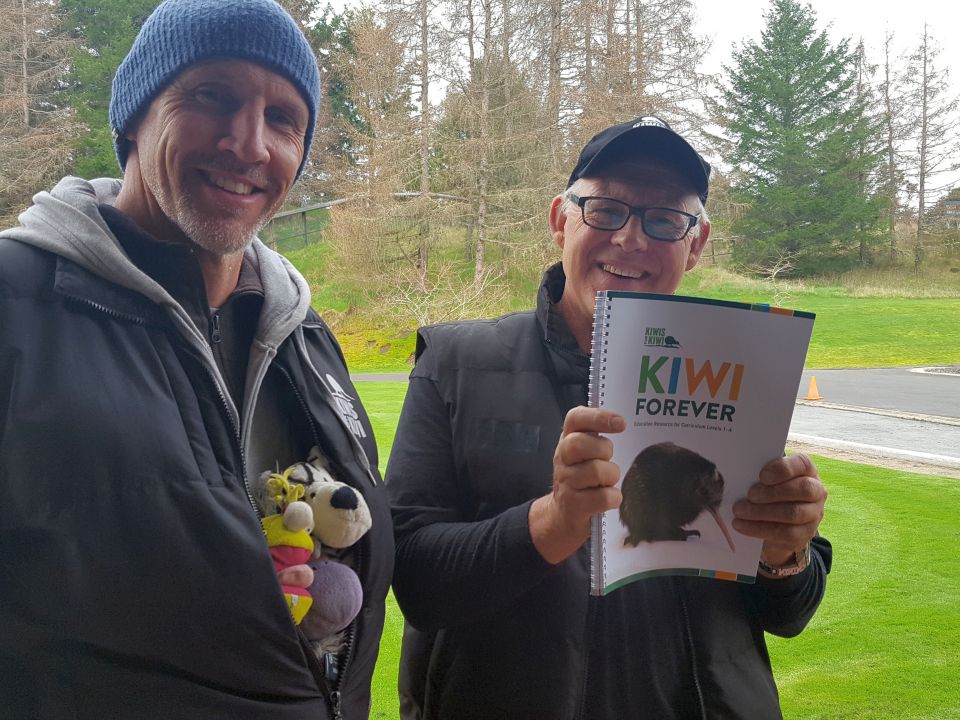
Andrew and Ruud with the final word of the field trip. Make sure you order your free copy of Kiwi Forever.
Day 3 reading diary
Kia ora everyone, Andrew here,
This morning we headed back to Wairakei Golf Sanctuary. It was time to complete the circle of Operation Nest Egg by finding a young, captive reared kiwi and returning it to Tongariro Forest.
The search begins
The search for this young kiwi was a bit different to locating and lifting the egg. Eggs don’t run, but kiwi do! We had a small team of 5 DOC staff, as well as me and Ruud Kleinpaste, to make sure that once we located the bird, it wouldn’t get away. Kiwi are quite agile and can dart through a forest at a pretty quick pace.
We loaded up three golf carts and went off in convoy to a likely area where the kiwi would be. At first, we just drove through the golf course, but soon we were “off-road” and heading towards a more forest-like area. The electric golf carts were able to negotiate the terrain better than I thought they would!
Soon we were parked up, and Renee Potae and Jenny Hayward quickly got to work with their telemetry gear to pick up a signal from the young bird’s transmitter. I could hear some faint beeping which meant we were in the general area. The ambassadors were excited - it was a positive start!
A bird in the hand
The kiwi proved somewhat difficult to track. We had disturbed it, so the little critter decided to make a run for it. We split into smaller teams and pushed our way through some thick undergrowth, following the moving signal as we went. Eventually, we managed to circle an area where the kiwi had tried to hide. As we closed in, it made another dash for freedom right into the safe hands of Luke - one of the DOC team from Whakapapa. Success!
Health check
With the kiwi safely in hand, it was time to give it a health check and change its transmitter. These are important tasks as you don’t want to be returning a young kiwi back into the wild if it isn’t healthy, nor do you want a transmitter running out of battery! The team chose me to hold the kiwi while they examined it. I felt very lucky to be able to hold such a special bird.
I was amazed at how coarse its feathers were - they felt more like ponga leaves than feathers. Every now and again it made a snapping sound with its beak. Jenny said this was a defence action. I had to grip its feet and legs firmly and just let it lie on my lap While Renee checked it over. They felt much like chicken legs, and I could feel the warmth of its little body as it rested on me. Its dark eyes looked at nothing in particular, and I could see small holes in its head that was where its ears were. The other amazing thing I noticed was how many whiskers it had that were sticking out at all angles. It looked so strange for a bird to have these whiskers but is another reason why kiwi are so unique.
Be sure to watch the video of this health check and observe the young kiwi up close for yourselves.
From lifted egg to free adult
With a healthy tick of approval and a weight at just over a kilo, the young kiwi was ready to head back into the wild. Jenny talked us through the procedure for this, and I suggested that it must be satisfying work to complete the Operation Nest Egg cycle - from lifted egg to free adult. Jenny agreed and added that another enjoyable part of her job is when the released kiwi then goes on to find a mate and produce eggs of its own. It sure doesn’t get much better than that!
Karakia for kiwi
We also had a kōrero with Matt Howell, another DOC ranger. Matt shared with us the importance and value of karakia before returning kiwi back to their original rohe. Because kiwi hold a special place in Māori culture, and to recognise the important relationship between living things and the land on which they were born, there is often a ceremony by mana whenua to welcome young kiwi back to the place of their birth. Watch the video to hear more from Matt.
Final web conference
After some well-earned lunch, it was time for our final web conference. Ngatimoti was our speaking school with Jenny and Ruud answering the questions. I have learned a lot from the web conferences over the last three days. You can listen to the recordings at any time on the web conferences page.
The future of kiwi conservation
The day finished off with a chat with Ruud Kleinpaste about his thoughts on the future of kiwi conservation. Ruud says that teaching and learning play an important part - so make sure you get the newly released Kiwi Forever education resource. It is free to schools, just visit Save the kiwi to order your copy.
Ruud also talks about genetic biocontrols as a way to get rid of predators. Scientists are working on gene-editing tools that could be used to disrupt a gene in predators such as stoats that is vital for survival or reproduction of these animals. Then, using what is known as a gene drive, scientists could engineer that gene to spread through the population. It is an area of science still being explored, but one that could end up playing a vital role to replace the likes of 1080.
Final word about Operation Nest Egg
It's been such an adventure this week finding out how Operation Nest Egg works. I’m tired, but there is still a smile on my face from being part of such an amazing experience. You have met some very dedicated people helping to protect this iconic species. And the great thing is you can also play a part. You've been doing it this week by learning about kiwi conservation - now you can share your learning with others. You can also find out what’s happening for kiwi recovery in your community and offer to help , or you could come up with your own plan. Who knows, you might just end up being part of the next big thing in kiwi recovery.
See you on another field trip soon!
Ka kite anō,
Andrew



